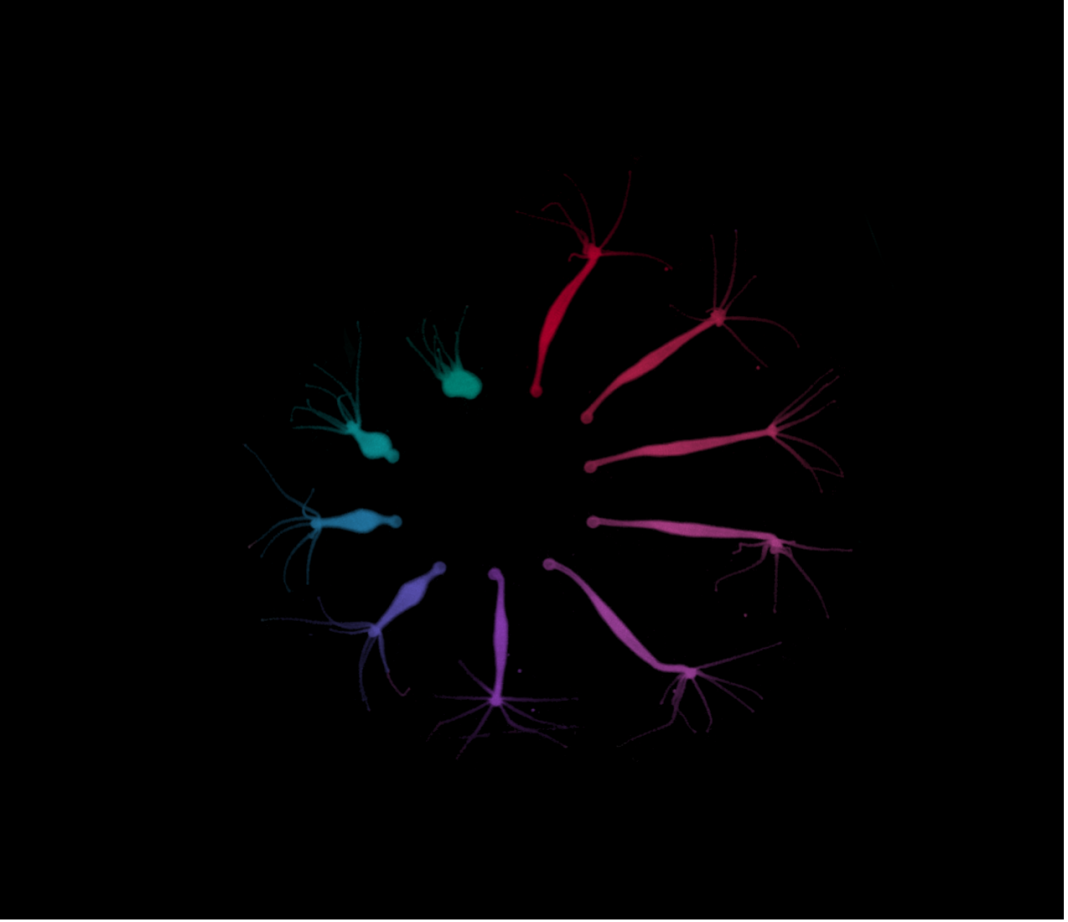Here, Charisios Tsiairis from Friedrich Miescher Institute for Biomedical Research explores Hydra Regeneration and the genetic programs that make it possible
Most people know jellyfish and other Cnidarians from painful stings while swimming in the sea. This is an unfortunate way of seeing these fascinating creatures that are among the first multicellular animals to evolve on our planet. While most Cnidarian species are found in marine habitats, a notable exception is the freshwater polyp Hydra.
What are Hydras?
Hydras inhabit pristine springs throughout the world and are shaped as hollow tubes constructed by two epithelial layers. On one end of this tube, a foot structure helps the animal to attach to solid substrates. These substrates can be rocks, wooden sticks, or even shell of aquatic snails, with which the animals are transported. On the end opposite to the foot, there is a mouth, a single opening surrounded by tentacles, that allows the animal to feed. For centuries, Hydras have captivated biologists for their natural ability to regrow a whole organism from a small piece of tissue. Indeed, the animal is named after a mythical serpent monster that regrew two heads for every head chopped off.
Hydra was first described by Abraham Trembley, a Genevan naturalist who wanted to find out whether it was an animal or a plant. To do so, he collected many individuals and cut them into halves along the middle of the body. Trembley reasoned that if Hydra were an animal, it would not sustain such a body part loss and die. However, if it were a plant it would regenerate. To Trembley’s amazement, Hydra was able to rebuild the missing part and regenerate — from every piece of its body — a complete individual sporting a functional mouth and foot. Actually, today we know that even if a Hydra is dissociated into single cells, these cells can re- aggregate into small clumps from which complete animals will emerge.
Trembley eventually categorized Hydra as an animal due to its motility and active search for prey, and his discovery opened a whole field of experimental investigation of Hydra regeneration phenomena. Regeneration is intriguing because not all animals are able to regenerate and, unfortunately, humans’ regenerative abilities are rather limited. Why organisms such as Hydra can replace missing parts, whereas humans can’t? And how do cells self-organize into complex tissues to rebuild missing structures?
Using genetic screens
To address these and other biological questions, biologists typically turn to genetic screens — laboratory procedures used to create mutant organisms and identify those that differ from the typical organisms’ physical traits or phenotypes. Genetic screens can provide important information on how genes determine a specific phenotype, but they have proven technically difficult in Hydra.
Our research team has devised an alternative approach to uncover the genetic toolkit that allows Hydras to regenerate. We cut tissue fragments from Hydras and let them regenerate in the presence of chemicals that interfere with the function of specific gene products. Then, we identify instances where regeneration fails or proceeds abnormally. In the presence of some chemicals, Hydras cannot recognize what body structures are missing, or their cells can’t acquire identities of the missing parts. In many cases, the proper exchange of information between cells is compromised, leading to multiple heads or foot structures.
Intercellular communication
So far, our work has pointed towards known and unknown genes involved in Hydra regeneration. For example, Wnt signaling is a communication system that Hydra’s cells use to establish the identity of the future mouth during development and regeneration. This intercellular communication mechanism is active in all multicellular systems. Some of the genes that we identified encode for proteins that facilitate cell-to-cell communication through the Wnt signaling pathway, suggesting that our approach is effective.
Moreover, we have identified many new genes involved in other signaling cascades and biological processes. Among them, we aim to identify genes that allow the exchange of biochemical information among cells, and those that enable cells to interpret and use mechanical cues. Indeed, we have recently shown that Hydra’s cells must stretch for the regenerating tissue to establish the future mouth of the animal. In fact, the more the cells are stretched, the easier it is for them to acquire the mouth identity and organize the emergence of the oral end structures. How is the mechanical signal translated into the chemical language of life? Which genes are involved in sensing physical forces and driving cell fate changes? The answers to these questions may lie in those newly discovered genes.
The importance of Hydra research
Hydra research can help us to identify genetic programs that may be present in our own cells, just waiting to be tapped. It could also help us to understand the mechanism of common diseases. For example, the information exchange through Wnt signaling is implicated in multiple cancers, and researchers are now starting to recognize a connection between this signaling cascade and mechanical cues. This link seems to be present in some of the earliest multicellular species, testifying to the importance of mechanical signals for the proper behaviour of cells. Hydra research can help us to understand this and other intriguing connections. Without a doubt, these tiny freshwater creatures promise a future of exciting discoveries.
Further Reading
- Vogg MC, Galliot B, Tsiairis CD. Model systems for regeneration: Hydra. Development 146, (2019).
- Ferenc J, Papasaikas P, Ferralli J, Nakamura Y, Smallwood S, Tsiairis CD. Mechanical oscillations orchestrate axial patterning through Wnt activation in Hydra. Sci Adv 7, eabj6897 (2021).

This work is licensed under Creative Commons Attribution-NonCommercial-NoDerivatives 4.0 International.


